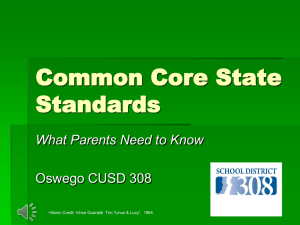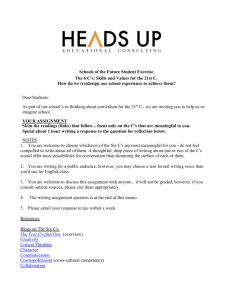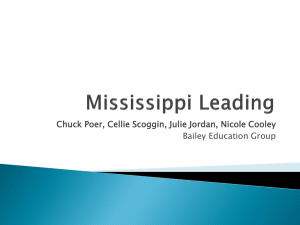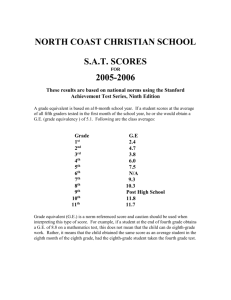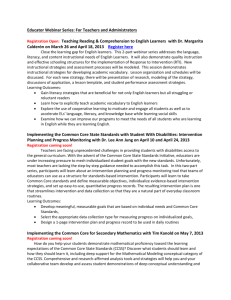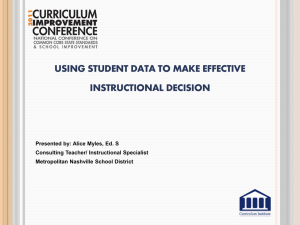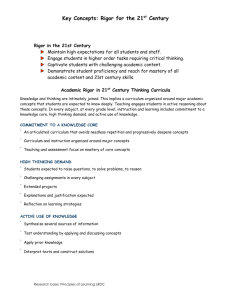Successful Schools: From Research to Action Plans
advertisement
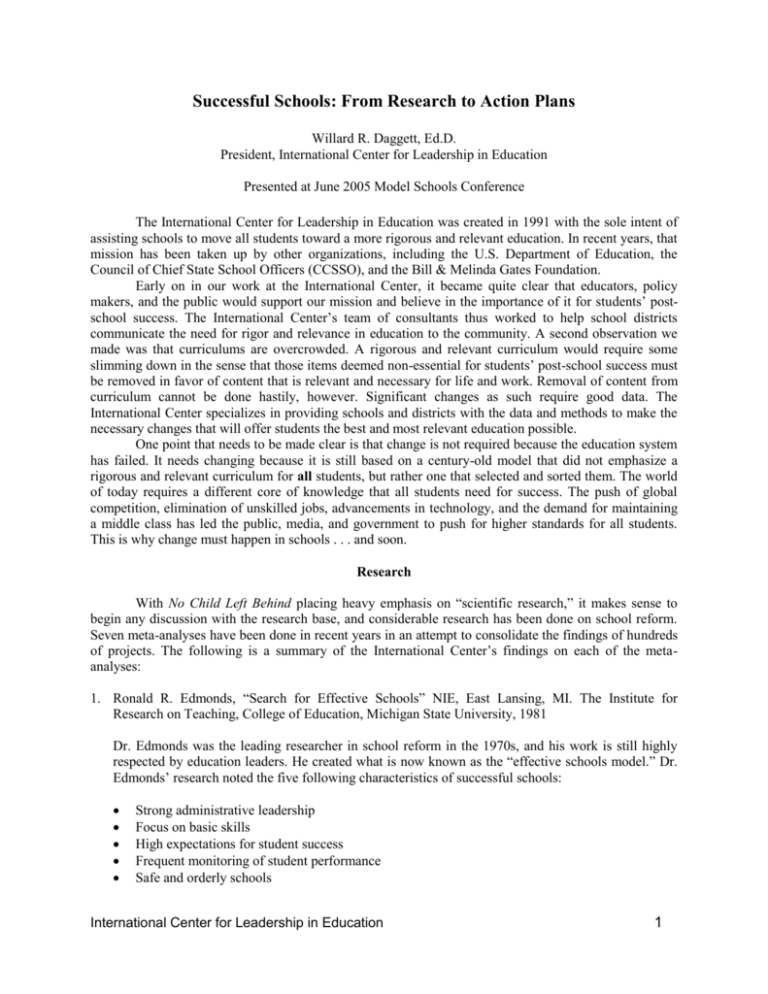
Successful Schools: From Research to Action Plans Willard R. Daggett, Ed.D. President, International Center for Leadership in Education Presented at June 2005 Model Schools Conference The International Center for Leadership in Education was created in 1991 with the sole intent of assisting schools to move all students toward a more rigorous and relevant education. In recent years, that mission has been taken up by other organizations, including the U.S. Department of Education, the Council of Chief State School Officers (CCSSO), and the Bill & Melinda Gates Foundation. Early on in our work at the International Center, it became quite clear that educators, policy makers, and the public would support our mission and believe in the importance of it for students’ postschool success. The International Center’s team of consultants thus worked to help school districts communicate the need for rigor and relevance in education to the community. A second observation we made was that curriculums are overcrowded. A rigorous and relevant curriculum would require some slimming down in the sense that those items deemed non-essential for students’ post-school success must be removed in favor of content that is relevant and necessary for life and work. Removal of content from curriculum cannot be done hastily, however. Significant changes as such require good data. The International Center specializes in providing schools and districts with the data and methods to make the necessary changes that will offer students the best and most relevant education possible. One point that needs to be made clear is that change is not required because the education system has failed. It needs changing because it is still based on a century-old model that did not emphasize a rigorous and relevant curriculum for all students, but rather one that selected and sorted them. The world of today requires a different core of knowledge that all students need for success. The push of global competition, elimination of unskilled jobs, advancements in technology, and the demand for maintaining a middle class has led the public, media, and government to push for higher standards for all students. This is why change must happen in schools . . . and soon. Research With No Child Left Behind placing heavy emphasis on “scientific research,” it makes sense to begin any discussion with the research base, and considerable research has been done on school reform. Seven meta-analyses have been done in recent years in an attempt to consolidate the findings of hundreds of projects. The following is a summary of the International Center’s findings on each of the metaanalyses: 1. Ronald R. Edmonds, “Search for Effective Schools” NIE, East Lansing, MI. The Institute for Research on Teaching, College of Education, Michigan State University, 1981 Dr. Edmonds was the leading researcher in school reform in the 1970s, and his work is still highly respected by education leaders. He created what is now known as the “effective schools model.” Dr. Edmonds’ research noted the five following characteristics of successful schools: Strong administrative leadership Focus on basic skills High expectations for student success Frequent monitoring of student performance Safe and orderly schools International Center for Leadership in Education 1 2. Jaap Scheerens and Roel Bosker, The Foundations of Educational Effectiveness, New York: Elsevier, 1997 Scheerens and Bosker’s work was well recognized and embraced in the mid to late 1990s. They did research on a wide variety of school reform initiatives and came up with eight essential characteristics of successful schools. The characteristics they identified were: Monitoring of student progress Focus on achievement Parental involvement Creating a safe and orderly climate Focused curriculum Strong leadership Cooperative working environment Time on task 3. “Key High School Reform Strategies: An Overview of Research Findings.” U.S. Department of Education, 1999. For this report, a team of researchers studied the 300 most comprehensive school reform research studies done in the previous five years. The common characteristics they identified were as follows: Commitment to high academic expectations Small learning environments Structure learning around career/student interest Professional development focused on instruction Tie out-of-school learning to classroom learning Career and higher education counseling Flexible, relevant segments of instruction Assess on what students can do Partnerships with higher education Support alliances with parents and community 4. Robert J. Marzano, What Works In Schools – Translating Research Into Actions. ASCD, 2003. Robert Marzano reviewed research on school reform in his new book. The five characteristics he identified for highly successful schools were as follows: Guaranteed and viable curriculum Challenging goals and effective feedback Parent and community involvement Safe and orderly environment Collegiality and professionalism 5. “High Poverty – High Success: Schools That Defy The Odds,” Quick and Quick, Leadership Media, 2000. In June 2000, Drs. Doris Quick and Custer Quick, Senior Consultants at the International Center for Leadership in Education, did an analysis of five models of high achieving schools. They studied the International Center for Leadership in Education 2 90-90-90 Schools, No Excuses Schools, Benchmark School Study, the Hope for Urban Education study, and the Beating the Odds study. They reviewed the characteristics that each of these major initiatives had found to be central to student success and established the following five overriding characteristics: A commitment to a rigorous and relevant curriculum for all students Implementation of a testing program that evaluated both students’ conceptual knowledge and their ability to apply knowledge A focused and sustained staff development program Commitment to addressing the issue of student behavior Willingness to make organizational changes for the benefit of students 6. The Bill & Melinda Gates Foundation Education Reform Strategies – Foundation Definitions of Effective High Schools, Targeted Literature Review of Major Constructs and Their Components: Evaluating the National School District and Network Grant Program, 5/30/02. The Bill & Melinda Gates Foundation has made a major commitment to school reform, especially at the secondary school level, following an extensive review of the research on the components of successful schools. The characteristics they identified as most important were: Common focus on a few research-based goals High expectations Small, personalized learning environment Respect and responsibility for all Parent/community partnership Focus on performance Effective use of technology tools 7. Lawrence W. Lezotte, Robert D. Skaife, and Michael D. Holstead, Effective Schools – Only You Can Make A Difference, All Star Publishing, 2002 In recent years, Larry Lezotte has picked up leadership on the effective school research that Ron Edmonds started in the 1970s. In his recent book, Lezotte noted the following as the most important characteristics of effective schools: Creating the school culture The correlates of effective schools Site-based management Data collection, disaggregation and analysis School improvement plans process Organizing schools for students Building community support Evaluation of student progress A comprehensive analysis of this research yields ten central findings that I believe schools should use as a platform for success in their reform initiatives: 1. Create a culture that embraces the belief that all students need a rigorous and relevant curriculum and all children can learn. International Center for Leadership in Education 3 2. Use data to provide a clear unwavering focus to curriculum priorities that is both rigorous and relevant by identifying what is essential, nice to know, and not necessary. 3. Provide students real-world applications of the skills and knowledge taught in the academic curriculum. 4. Create a framework to organize curriculum that drives instruction toward both rigor and relevance and leads to a continuum of instruction between grades and between disciplines. 5. Create multiple pathways to rigor and relevance based upon a student’s personal interest, learning style, aptitude, and needs. 6. Set high expectations that are monitored and hold both students and adults accountable for student’s continuous improvement in the priorities identified in #2 above. 7. Sustained professional development that is focused on the improvement of instruction. 8. Obtain and leverage parent and community involvement successfully in schools. 9. Establish and maintain safe and orderly schools. 10. Offer effective leadership development for administrators, teachers, parents, and community. Characteristics of Successful Schools In 2004, through feedback from several schools we were working with, it became apparent that, though the meta-analysis research was valuable and appreciated, their most urgent need was a series of specific characteristics they could readily adopt that would help their schools in the short term. In turn, the International Center, in conjunction with the Council of Chief State School Officers and with financial support from the Bill & Melinda Gates Foundation, conducted a study on the most successful high schools in the country, paying close attention to their feeder elementary and middle schools, to try to understand the characteristics that made them effective schools. This investigation provided nine central characteristics of high performance in high schools: 1. Focus instruction around students’ interests, learning styles, and aptitudes through a variety of small learning community approaches—most commonly academies. 2. Administrators and teachers share an unrelenting commitment to excellence for all students, especially in the area of literacy. 3. An extraordinary commitment of resources and attention to ninth grade students. 4. A rigorous and relevant twelfth grade year. 5. A laser-like focus on data at the classroom level to make daily instructional decisions for individual students. 6. High-quality curriculum and instruction that focuses on rigor and relevance. 7. Provide students with adults with whom they can develop personal relationships and be allowed the opportunity to use reflective thought. 8. Focus and maintain professional development around a limited number of high-impact initiatives. 9. Solid and dedicated leadership. International Center for Leadership in Education 4 Action Plan As the International Center continues its work with and listens to schools, it is abundantly clear that schools understand and embrace the research and are gaining a clearer understanding of characteristics that high-performing schools possess. Schools now seek direction and support in developing specific action plans to implement these characteristics. To assist schools in this effort, the International Center for Leadership in Education has created the Successful Practices Network. The Network was launched two years ago, starting out with a group of schools with whom we had working relationships. It is apparent from our work with these founding members of the Successful Practices Network that considerable resources and technical assistance is needed by most schools to be able to move forward with an action plan. Schools are so overwhelmed by the mountains of regulations, requirements, tests, and reporting they have to do that there is little time or energy left to feasibly implement an action plan. The International Center has again partnered with the Council of Chief State School Officers to begin a detailed dialogue about how to support a group of selective schools in moving forward with an action plan. After extensive discussion, a five-year plan was developed to assist these schools. The International Center reached out to the Bill & Melinda Gates Foundation for assistance in providing resources to help the initiative, and we are deeply grateful and honored that the Foundation agreed to help. We have developed, in consultation with many national organizations including NEA, AFT, National School Boards Association, National Governor’s Association, Achieve, Education Trust, ASCD, U.S. Department of Education, and others, the criteria of how to identify a highly successful school. The criteria include four characteristics: 1. High academic performance in core areas as measured on state and national tests. 2. Programs that stretch students well beyond the core academic skills measured by state and national tests. 3. Community involvement. 4. Social and personal development. The International Center has developed a detailed rubric to measure success in each of these four areas. Working with CCSSO, we are now in the process of selecting 25 “proven” high schools, given their socio-economic characteristics, that appear to be the nation’s most successful based on the above criteria. These schools will represent a cross section of the nation’s community settings based on socioeconomic characteristics. Subsequently, a group of 75 “promising” schools from ten targeted states will be added to the Network. Finally, we will add the existing schools in the Successful Practices Network together with a select group of additional schools that show an interest and capacity to make substantial improvements in their schools. Together, these schools will all become part of our Successful Practices Network. These schools will then begin work on an action plan. The action plan will consist of up to eight initiative areas that any K-12 school system nationwide can use to be successful. The International Center and our Successful Practices Network will provide technical assistance and support to these schools in selecting the areas of improvement. Following are the seven central actions that we believe schools must take, those which members of the Successful Practices Network will have the opportunity to participate in, if they are to improve the academic success of all students. International Center for Leadership in Education 5 1. Creating a Culture that Supports Change Most educators did not enter public education because of a burning desire to raise test scores. They did so because of a desire to prepare and assist children for success in life. To do this, we must realize that our children are growing up in a world altogether different than we knew as children. Young people are being pushed to respond to the economic pressures presented by a highly skilled global workforce and a growing number of retirees who will rely on them to support social security. Modern technology requires a different skill-set than the past. Our students are lagging behind their peers from many other nations in acquiring the relevant, modern-day skills necessary to compete. School districts must find a way to communicate this message clearly and unmistakably to administration, boards, teachers, students, and parents. Until schools can spread public awareness and get acceptance of these issues by all of these groups, every effort for change will be resisted and eventually die on the vine. The highest performing schools in America understand this, have persevered, and overcame the challenges they faced. The International Center for Leadership in Education has developed a wide variety of resources that can assist schools in this process. 2. A Focus on Instruction Rather than Structure Increasingly throughout the country, schools have come to understand the need to move towards a more rigorous and relevant curriculum. This message has been made loud and clear by the U.S. Department of Education, many state education departments, the Bill & Melinda Gates Foundation, etc. From the International Center’s 15 years of experience in promoting rigor and relevance we know that the concept is often discussed, but only the highest performing schools have understood how to implement it. Too often schools get caught up in trying to make structural changes such as moving to a small learning community, to block schedules, to magnet or charter schools, to year round schools, etc. They do this intending to create a different structure that will develop a closer personal relationship with students and make their education more relevant. Unfortunately, these changes are extremely emotional and take on many sacred tenets of instruction. Our experience has taught us that, while all of the above structural changes can be beneficial, more often than not they lead to such emotional upheaval in the community that they drain the energy, support, and resources for any additional substantial change. Another strategy that has had some success is to not attack the structure of schools but rather the instruction that occurs at the classroom level. This is far less emotional and teachers who are adaptable can alter their techniques in a short time. The problem here is that not everyone will get with the program. We have found that you can count on faculty splintering into three camps. One group will be enthusiastic about change, one group will accept it as policy but not immediately embrace it, and a third group will resist change at all cost. Over time, most faculty members will come around, but it is a struggle to get to that point. If teachers are to change their instruction methodologies, they need materials and training that are concrete and specific, not a vague concept. They need resources that they can employ in their classrooms the very next day. The International Center developed the Rigor/Relevance Framework to do just that. International Center for Leadership in Education 6 Rigor/Relevance Framework K N O W L E D G E Evaluation 6 Synthesis 5 Analysis 4 Application 3 Comprehension 2 Knowledge C D Assimilation Adaptation A B Acquisition Application 1 1 Knowledge in one discipline 2 Apply knowledge in one discipline 3 Apply knowledge across disciplines 4 Apply knowledge to real-world predictable situations 5 Apply knowledge to real-world unpredictable situations APPLICATION The Rigor/Relevance Framework requires all students to have academic rigor but, equally important, they must also understand and conceptualize relevant applications for each academic standard and benchmark being taught. Studies have shown that students understand and retain knowledge best when they have applied it in a practical, relevant setting. A teacher who relies solely on lecturing does not provide students with optimal learning opportunities. When implementing the Rigor/Relevance Framework in a classroom, school, district, or state, it is of great importance to develop local and—as Florida is working to do—state assessments that measure D quadrant skills. This enables students to not only gain knowledge but to develop skills such as inquiry, investigation, experimentation, and how to use trial and error. With the Rigor/Relevant Framework firmly in place, schools can then begin to look at the other meaningful structural changes, such as small learning communities, that will indeed play to a child’s interests, learning style, and aptitude. The Rigor/Relevant Framework will also bring to the classroom a structure that makes instruction easy and enjoyable for teachers. 3. Developing Relationships within the Building Students who attend high-performing schools have personal relationships with adults and peers in their building. These relationships are not forced, but seemingly woven into the fabric of the schools. For students to become all they are capable of being, they need ongoing direction and assistance. Schools that create an environment where one or more adults interact intimately with a child on a consistent basis will benefit the student greatly. A school committed to building personal relationships also understands the equally critical importance of adults communicating with each other. If we are to have an intimate understanding of our students and their lives, we need to interact with their parents as well. In order to prepare students adequately for a “D-quadrant” world, they will need not only rigorous and relevant academic experiences, but also skills in working with others in a wide variety of settings. High-performing schools use a range of techniques and strategies to create personal relationships: International Center for Leadership in Education 7 Before the child is enrolled in class, teachers obtain from parents some basic information about their child’s interests, learning style, and aptitudes. This sort of background information is essential in order to understand the students and help them grow. Teachers make monthly phone calls to parents to brief them on their child’s progress and to obtain in return any new advice or significant goings on at home. In high schools, freshmen are assigned peer coaches who are juniors and seniors. Peer coaches need to be good role models for the younger student and also communicate well with the adult faculty member who looks after the student. The team of the peer coach, the teacher and/or adult faculty member assigned to the child, the parent, and the child periodically get together to share observations and discuss ways each of them can improve. Almost certainly there will be some school faculty members who refuse to embrace the added responsibilities that go along with developing a close relationship with a student and his or her parents. The “It’s not my job!” argument comes into play. School administrators need to be direct and uncompromising in convincing them otherwise. Naturally, as an administrator, it helps to have teachers in your camp who are enthusiastic about change and can assist in changing the attitudes of their more reluctant colleagues. Efforts must be made to hire and retain staff who share the vision. By the time students are 18 years of age, they will have only spent 13 percent of their waking hours in school. Parents can and should, therefore, have a very profound impact on their children’s education. It will never be easier than now to enlist their support. Parents today have different expectations and value their children’s education more than in the past. Oftentimes, their involvement may seem excessive and border on inappropriate. They may concern themselves more with what you have done to their children than what you are doing for their children. The label of “helicopter parents” is right on the money. They hover over their children incessantly and their protect-the-child-at-all-cost attitude has even driven some teachers out of the profession. Educators should use this newly found interest in their school to their advantage. No longer will it be difficult to impossible to involve them in important discussions about their children, school, and other education issues. In fact, the change in the culture of parenting is often the opposite of what it used to be; almost to an extreme with some of the helicopter parents. Millennials and their parents rely on e-mail and cell phones for communicating. It is suggested that the adult faculty member working with the child and parent use these open lines of communication for relationship building. We need to recognize parents for what they are, dedicated caregivers who can be a tremendous resource for educators who for decades, have wanted more parental involvement in children’s education. Every year more and more parents are pulling their kids out of public education and schooling them at home. In fact, home schooling is the fastest growing method of delivering K-12 education in America. These students have no regulations, no buildings, no certifications, and no state tests but are outperforming students in public education overall. If public education is to survive, we need to integrate some of the best aspects of home schooling, i.e., parents as stakeholders, into our classrooms. Finally, it is very important that the schools establish a series of guiding principles for all relationships to be built around. The guiding principles that many schools use are those from the character-centered teaching initiative that exists in the U.S. They are: 1. Respect 7. Perseverance 2. Responsibility 8. Honesty 3. Contemplation 9. Optimism 4. Compassion 10. Trustworthiness 5. Initiative 11. Courage 6. Adaptability 12. Loyalty International Center for Leadership in Education 8 Schools today can create relationships with and around the child that exemplify these guiding principles. They will go a long way in preparing that child for success in all aspects of life. 4. Start with Special Education and English as a Second Language Students Most schools in America attempt to mold a curriculum to the average to above-average student and then try to figure out how to shape it to fit the special education (SE), English as a second language (ESL) students, and talented or gifted students. High-performing schools do the opposite. In developing curricula, high-performing schools will typically focus on nine central factors in planning student education and instruction. These factors are: 1. Using data, they carefully weigh content that is essential versus content that is nice to know but not critical for success after graduation. 2. They go to great ends to fully understand the interests, learning style, and aptitudes of each student. 3. They engage parents actively in a discussion of the child’s needs and how to meet those needs most effectively. 4. They use proven methodologies to teach to the unique interests, learning style, and aptitudes of each student. 5. They monitor the success and failures of students on an ongoing basis and take appropriate corrective actions. 6. They stay current with the research and data on learning and integrate it into the classrooms. 7. They focus on the end result for students, which is to prepare them for work, college, family, and community participation rather than solely on standards and assessments. 8. They use technology to improve the learning opportunities for students. 9. They break learning down into its smallest incremental parts to guide instruction for students. These nine characteristics are not uniquely suited to help SE and ESL students—they are good for all students. High performing schools begin by determining the needs of the hardest to serve students then by applying the same principles to the other students. The result is dramatic improvement for all students. To do this, schools must create a culture that supports the belief that all children can learn, that a big majority of students can meet the standards, that more students than are presently meeting the standards can do so, and that we generally have too low of an expectation level for our students. Another reason to focus on SE and ESL is that both of these groups will grow dramatically in number in the coming years. The demographics of America will continue to shift as immigration brings more students with limited English speaking ability and children in poverty into schools. Advancements in health care will make more young children with disabilities well enough to enter general education programs. In schools throughout the country we have found that elementary, SE, and ESL educators have a tendency to focus more on students and less on content. In middle schools and high schools, the teachers have a tendency to focus more on content and not on individual students. It is this attention to students that will help improve the performance of all students because it replaces a focus on teaching with a focus on learning. International Center for Leadership in Education 9 Because of their tendency to focus on the total needs of children, high-performing schools nationwide are increasingly placing SE, ESL, and elementary educators in leadership roles in both individual buildings and across the district at the principal level and at curriculum leadership levels. 5. Data-based Decision-making Good data is a necessary ingredient in any curriculum restructuring initiative. American curriculum is so overcrowded with content that it is difficult for teachers to provide students with the process skills that enable them to know how to apply the content being taught. Teaching students how to apply knowledge takes considerable time, which teachers simply do not have. Therefore, schools need to make some difficult decisions regarding content that is essential versus that which is nice to know so that time can be made available for teaching process skills. Prisoners of Time, a study by the National Education Commission on Time and Learning, reported that as of 1994, 11 states permit school terms of 175 days or less and only one state requires more than 180 days. If one accepts the Prisoners of Time estimate of 5.6 hours of classroom time per day in a school year of 180 days, there is a total of 13,104 hours of classroom time in 13 years of K-12 schooling. The highest estimate of the percentage of time that is typically allocated to instruction within the current system is 69 percent. This means that of the 13,104 available hours, teachers have 9,042 hours to teach, reinforce, and assess the knowledge identified in the average state curriculum. The Mid-continent Regional Education Laboratory, under the leadership of Bob Marzano, worked with a large number of teachers to determine how much time was needed to teach all the standards and benchmarks in the four core academic areas. Simply stated, they concluded that 15,465 hours of time was necessary; nearly 6,500 more hours than is available. High-performing schools have figured out how to eliminate many extraneous standards and benchmarks without sacrificing the quality and relevance of the students’ education. Their decisions are based on what students need to know and be able to do once they graduate, being mindful to cover content that will be tested on the state exams. It is amazing how few teachers are aware of the data that is available to them to make these types of decisions themselves. The International Center for Leadership in Education created the Curriculum Matrix to help districts make good decisions about the curriculum and focus their instruction. The Curriculum Matrix correlates a state's standards in math, science, and English language arts to that state's testing program and to the essential skills graduates will need in their post-school lives. The Curriculum Matrix is a user-friendly crosswalk of state standards to state assessments as well as the curriculum survey of essential skills, also developed by the International Center. High, medium and low instructional priorities are assigned to the standards based on the crosswalks. This is the type of data districts need to determine priorities that will help raise scores on the state-mandated tests and, equally as important, to focus instruction on skills/knowledge students need for success in their post-school responsibilities. The Curriculum Matrix Summary Table for Florida’s English language arts curriculum is provided below. It shows of the 521 benchmarks in Florida’s curriculum in grades three through twelve, 126 (or 24 percent) of them are assessed by the Florida Comprehensive Assessment Test (FCAT). The number of benchmarks tested is arrived at by summing the high (H) and medium (M) priority columns under the FCAT for all grades. The Curriculum Matrix is completed on a benchmark by benchmark basis, meaning each benchmark is aligned directly to the FCAT and the curriculum survey rankings. The summary table shown is intended to give an idea of how the Curriculum Matrix can be used as a platform to curriculum restructuring. International Center for Leadership in Education 10 International Center’s Florida Curriculum Matrix Summary Table Number of Standards Number of Benchmarks English LA FCAT H M L/ No Q Curriculum Survey of Essential Skills H M L 1-35 36-70 71 + Grade 3 11 51 10 7 34 31 8 12 Grade 4 11 51 16 1 34 28 13 10 Grade 5 11 51 10 7 34 28 13 10 Grade 6 11 52 10 5 37 22 18 12 Grade 7 11 52 10 5 37 22 19 11 Grade 8 11 52 14 1 37 22 18 12 11 52 14 1 37 25 11 16 11 52 14 1 37 25 11 16 Grades 9-12 Test 9th Grade Grades 9-12 Test 10th Grade The International Center has found that the data compiled in the Curriculum Matrix can be applied to career and technical education (CTE) and arts programs as well. Career and technical education students, in some schools, are outperforming college-prep students on state math, science, and English language arts tests. What these schools have done can be replicated in most CTE programs and lead to similar success. The schools compared the academic standards/benchmarks in their state to what was actually on the state tests in English, math, and science. Often, only a relatively small portion of the standards/benchmarks made up a majority of the test questions. They embedded this content in their CTE curricula and trained their CTE teachers to cover them. Not surprisingly, when taught these high-priority standards in an applied setting, the CTE students mastered them and performed well on the state tests. Once teachers are armed with data, they then need professional development to show them how to use the data to make daily decisions at the classroom level. The International Center’s experience with the high-performing schools has been that, unless professional development accompanies this data, teachers are often overwhelmed by it and not sure how to use it. A district that has received the proper training is then able to put information systems in place that will track how well students are doing on a state-wide, district-wide, school-wide, and classroom-by-classroom basis. At all levels of education, from the classroom to the state, it is critical that we assess what we value and not simply value what we assess. Tests need to be developed that are based in the D quadrant and then gear instruction towards getting students prepared to master the content covered in these assessments which will, in turn, provide them with valuable life skills. Some well-intended districts have found that their assessment policies were driving students in a direction opposite of what would be best for them. For example, a number of schools we have worked with found that high-performing students have shied away from IB and AP courses because it was negatively impacting their GPA. Other schools informed us that they were not providing Quadrant D instruction because the state tests were based in Quadrant A. Fortunately, many states have begun to take these issues seriously. For example, the state of Florida has completed a detailed analysis of the FCAT to determine where they place on the Rigor/Relevance Framework. Based on their evaluation, Florida is now looking at the necessary changes that will move the FCAT into Quadrant D. International Center for Leadership in Education 11 6. Transition Years As students progress in a high-performing district, the transition is smooth from pre-K to kindergarten, kindergarten to 1st grade, elementary to middle school, middle school to high school, and from high school to higher education or work. Let’s look at ninth grade as an example, although similar strategies and techniques are used at each of the other levels in which transition occurs between schools. When a student is in eighth grade, the transition to ninth grade/high school must begin early in the eighth grade. High performing schools and districts use strategies such as these: Eighth grade students are provided copies of the high school student newspaper. Teachers from ninth grade visit eighth grade classrooms on a regular basis. Parent’s night for eighth graders is held at the high school. Eighth graders visit the high school on at least two occasions. The eighth grade teacher loops to the ninth grade with the students. Detailed information about each student is collected in eighth grade and shared with ninth grade faculty before the students arrives in the fall. Once the student reaches ninth grade numerous initiatives are undertaken to ensure their success in the high school. Among these initiatives are: 1. Loop the eighth grade teachers to the ninth grade, which provides students with a contact person who they know and a person who knows them. 2. Assign the best teachers to ninth grade; those teachers who can best relate to students. 3. Implement a menu of intervention programs that will spring into action if a student runs into any difficulty. 4. Compilation of data is faithfully maintained in the ninth grade. Students are reviewed every six weeks and the evaluation is shared with parents and students and appropriate actions are taken. 5. Focus on literacy at all times. 6. Assign a high school junior and senior who is good role model to act as a peer coach to each ninth grade student. 7. Extend instruction and provide bussing for students who are struggling. Transition years are crucial. Moving to a new school in the district should not be a fractured event but a seemingly natural continuation of a student’s educational experience. 7. Systems High performing schools cannot be maintained without extensive support from the district and state. State departments of education have felt financial constraints over the last several years and have had to reduce their technical assistance staff and become more of a regulatory agency. This, we have International Center for Leadership in Education 12 found, has had a very negative impact in enabling schools to achieve high standards for all students. A similar circumstance exists in a large number of districts throughout the country. High performing schools emerge when the district and the state allocate their limited resources to assist teachers rather than regulate them. Support is provided in the following ways: Extensive resources in the area of curriculum and curriculum support services for classroom teachers. Technology is made available for classroom teachers Peer coaches are assigned to students. Professional development is widely available, but does not occur on district-wide staff development days. Instead districts use their limited resources to invite teachers to high-quality, well-focused professional development activities. The top one-third of teachers will jump at this opportunity. This proves to be a more cost effective use of resource. It is becoming increasingly clear that school districts across the country and state departments of education must find new and innovative ways to provide technical assistance to classroom teachers. Kentucky and Florida provide good models in this respect. International Center for Leadership in Education 13


